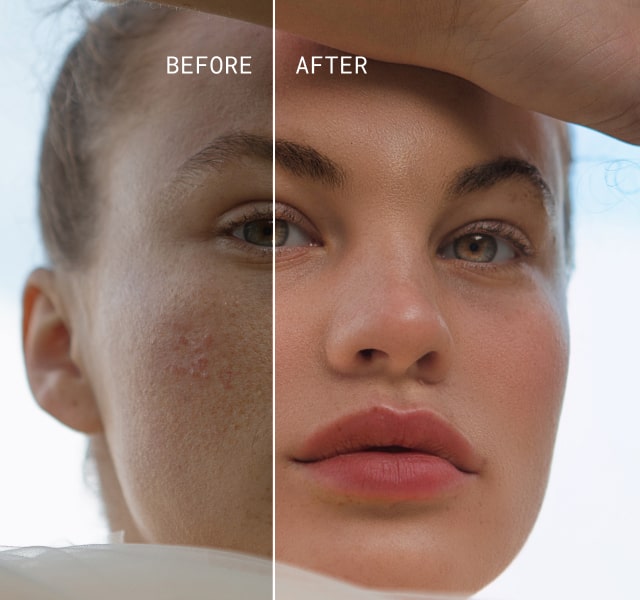より良いポートレートのための体の位置と角度の調整方法
2月 18, 2025
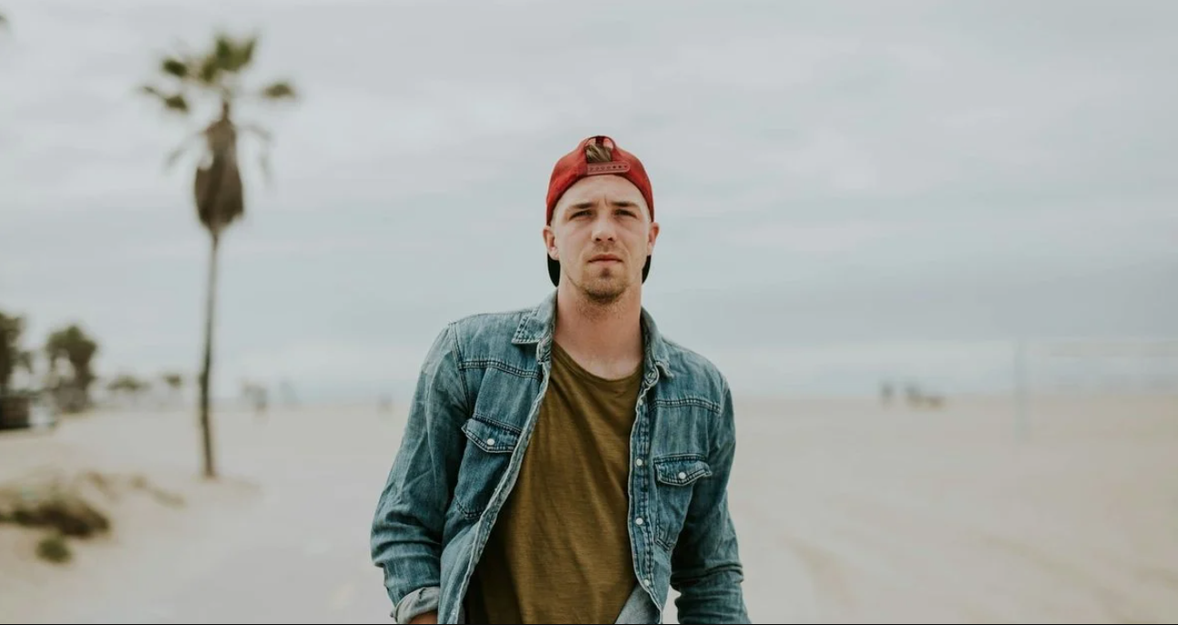
モデルと一緒に撮影することで、撮影に新たなダイナミズムが生まれます。モデルは、あなたのメッセージやストーリーをより効果的に伝えるだけでなく、見る人が写真に共感しやすくなるよう手助けしてくれます。
モデルと上手く連携するには、さまざまな要素を含む新たなスキルが必要です。まず、モデルの魅力を引き立てるライティング、色彩理論、構図の基本を理解することが重要です。さらに、モデルのポージングが不自然で気を散らすものにならないよう、適切に指示を出し、円滑にコミュニケーションを取るスキルも求められます。本日は、まさにこのポイントについて詳しく見ていきましょう。
モデルとの基本的な向き合い方
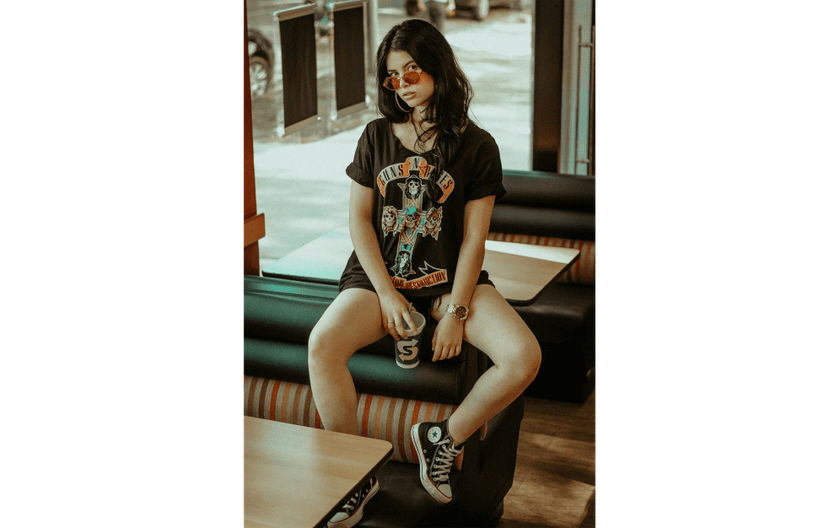
ポージングのテクニックを学ぶ前に、まずはモデルとの正しい接し方を理解することが重要です。写真家として、ライティングのセッティングや撮影、編集を担当するだけでなく、モデルを的確に指示する役割も担います。
創造力を解き放とう – プランを選んで編集開始
プランを見るここでは、モデルの魅力を最大限に引き出すための基本的なガイドをご紹介します。
- 計画撮影を計画する際、モデルに事前にどのような撮影をするのか、どのような雰囲気を目指しているのかを伝えましょう。ムードボードを送ったり、撮影の目的を明確に説明したりすると、イメージの共有がスムーズになります。撮りたいポーズの例を提示するのも効果的です。
- リラックスさせるモデルが現場に到着したら、すぐに撮影を始めるのではなく、少し落ち着く時間を設けましょう。飲み物を提供したり、軽く会話をしたりしてリラックスできる雰囲気を作ることが大切です。こうすることで、モデルとの信頼関係を築くことができ、撮影がスムーズに進みます。
- 確認撮影した写真を途中でモデルに見せるのも効果的です。これによって、撮影の進行を確認できるだけでなく、モデル自身がポージングや表情を調整するのに役立ちます。もちろん、この時点では写真はまだRAWの状態であり、最終的な仕上がりには編集が必要ですが、改善点を共有する良い機会となります。
- 休憩を取るモデルに定期的な休憩を与えることも忘れてはいけません。連続したポージングは身体に負担がかかるうえ、タイトな衣装や不自然な姿勢を続けると疲労が蓄積します。また、強い照明やフラッシュの光を浴び続けることで、集中力が低下する可能性もあります。休憩中にヘアメイクの直しや衣装替えを行うのも良いタイミングです。
私たちは、モデルにできるだけリラックスして快適に過ごしてもらい、撮影に最高のパフォーマンスを発揮してもらいたいと思っています。メイクやヘアを直したり、衣装を着替えたりするために休憩時間を使うこともできます。
写真撮影はエキサイティングなもので、私たちは自分の素晴らしいアイデアをすべて試すために、撮影をやり遂げようと躍起になるかもしれません。しかし、十分な休息を与え、モデルを落ち着かせることで、より幸せなモデルが素晴らしい結果を出すことになるのです。
キー・ポージング・テクニック
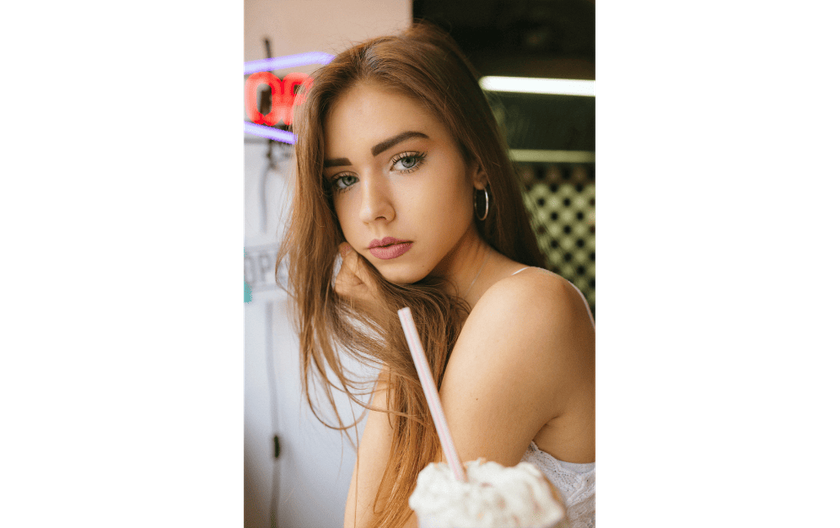
撮影中にポーズのアイデアが尽きないように、モデルに指示できるポーズのカタログを用意しておきましょう。これらのポーズをスマートフォンやノートパソコンのフォルダに保存しておくと、必要なときにすぐに参照できます。一連のポーズを振り付けられたルーチンのように考えることで、モデルがスムーズにお気に入りのポーズをこなし、より効率的な撮影が可能になります。
立ちポーズ
まずは、全身を映した立ちポーズの構図について見ていきましょう。ポーズが被写体を魅力的に見せるだけでなく、写真に奥行きと興味を加えることが大切です。
3/4ポーズ
このクラシックなポーズでは、被写体がカメラに対して45度ほど斜めを向きながらも、顔はカメラの方向へ向けます。ウエストラインが細く見え、シーンに奥行きを与えるため、非常に魅力的なポーズです。
体重の分配
モデルの体重を片足にかけるよう指示しましょう。これにより、ポーズがより自然になり、不自然な硬さを避けつつ、体の曲線を美しく演出できます。
動き
全身を使ったダイナミックなポーズを取り入れることで、写真に躍動感を加えることができます。特に、スポーツウェアの撮影など、エネルギッシュな雰囲気が求められるテーマでは効果的です。モデルに歩く・走る・スポーツの動作を再現してもらうのはもちろん、さまざまなダンスの要素を取り入れたアーティスティックな動きを指示するのも良いでしょう。さらに、軽やかに揺れる衣装や風になびく髪を活用することで、動きをより強調できます。
手や腕のポジション
「手の位置はどうすればいいの?」という悩みは誰もが抱えるものですが、不自然な手の配置を防ぐ方法はたくさんあります。モデルの手を腰に置いたり、顔の周りをフレームのように囲んだり、髪に触れたり、前や後ろで組ませたりと、さまざまなバリエーションを試してみましょう。避けるべきなのは、腕が硬直して緊張した状態になることです。もし腕を自然に下げるポーズを取る場合は、手がリラックスしていることを確認しましょう。
四肢の角度を作る
肘・膝・手首を適度に曲げることで、不自然で硬いポーズを防ぎ、写真に美しいシルエットを作り出せます。さらに、四肢の配置を工夫することで、視線を導くラインを作ることも可能です。たとえば、モデルの顔に視線を集めたい場合は、腕を顔の方へ上げ、手の位置で顔をフレームのように囲むと効果的です。
座るポーズ
家具を取り入れることで、よりスタイリッシュで興味深い構図を作り出せるだけでなく、ポーズのバリエーションも広がります。
姿勢とアライメント
デスクチェアの広告撮影など、正しい姿勢が求められる場合を除いては、椅子の上で自由にポーズを工夫してみましょう。一般的な座り方にとらわれず、環境と積極的に関わることでユニークな構図を生み出せます。たとえば、片側に大きく寄りかかったり、足を上げたり、椅子の上で横たわったり、背もたれに身を預けたりすることで、ダイナミックで面白い写真を撮ることができます。
手や腕のポジション
椅子に座ることで、手の置き場が自然になり、横に垂らすしかないといった不自然な状況を避けられます。手をアームレストや膝の上に置いたり、顔をフレームのように囲んだりすることで、視線を集める印象的なポーズを作り出せます。
脚の活用
座ることで、脚が顔の近くに配置されるため、フレーミングや視線誘導の要素として活用できます。脚を上げたり組んだりして、モデルの顔へと視線を引きつけるダイナミックなポーズを作りましょう。
もちろん、対称的なユニークな構図を狙う場合には、あえて直立したポーズが効果的なこともあります。しかし、多くの場合は、モデルの動きを柔らかくし、流れるようなラインを作ることで、より自然で美しい写真に仕上げることができます。また、四肢の配置を工夫して視線をモデルの顔へと導くことで、写真の印象を強めることができます。
創造力を解き放とう – プランを選んで編集開始
プランを見る角度を活用してポートレートを引き立てる
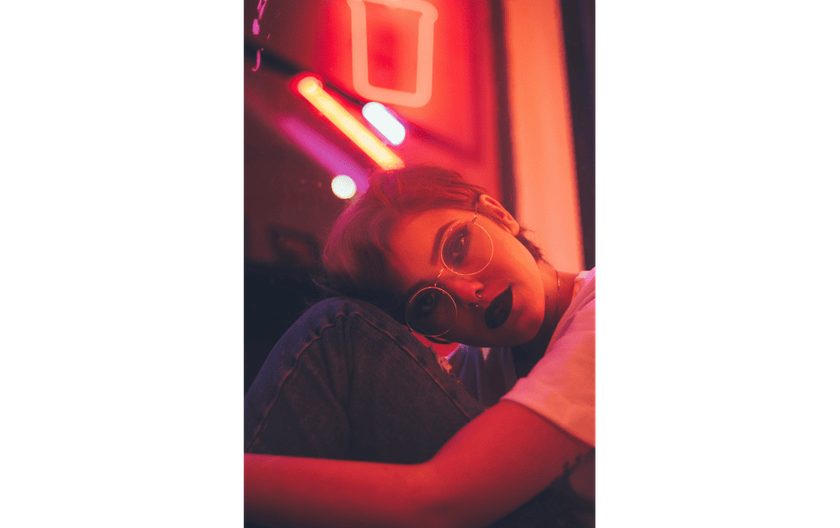
撮影の角度を変えることで、写真の印象は大きく変わります。これらの印象は多くの場合、無意識のうちに視聴者に影響を与えるため、撮影の目的やテーマに合った角度を選ぶことが重要です。
- アイレベルカメラを被写体の目線の高さに合わせることで、視聴者とのつながりが強まり、より親しみやすく、共感を呼びやすい印象を作り出します。人物を自然に魅力的に見せるため、最も一般的に使用される角度です。
- ハイアングルカメラを上から被写体に向けると、アイレベルとは大きく異なる印象が生まれます。被写体が小さく、弱々しく、または無防備に見えることが多いため、力強さや威厳を演出したい場合には避けるべき角度です。ただし、意図的に繊細さや可愛らしさを強調したい場合には効果的に活用できます。
- ローアングルカメラを下から被写体に向けることで、クラシックな「ヒーローポーズ」の構図が完成します。この角度では被写体が大きく、堂々と見え、支配力や権威を感じさせます。視聴者に強い印象を与え、被写体を尊敬や憧れの対象として見せたい場合に最適な角度です。
カメラの角度は、撮影のテーマに合ったものを選ぶことが重要です。特にポートレートでは、アイレベルやローアングルが多く使われます。これらの角度は被写体をより魅力的に見せ、視聴者に強い印象を与えるためです。一方で、ハイアングルは被写体の印象を弱める可能性があるため、使用する際は意図を明確にすることが大切です。
避けるべき一般的なミス
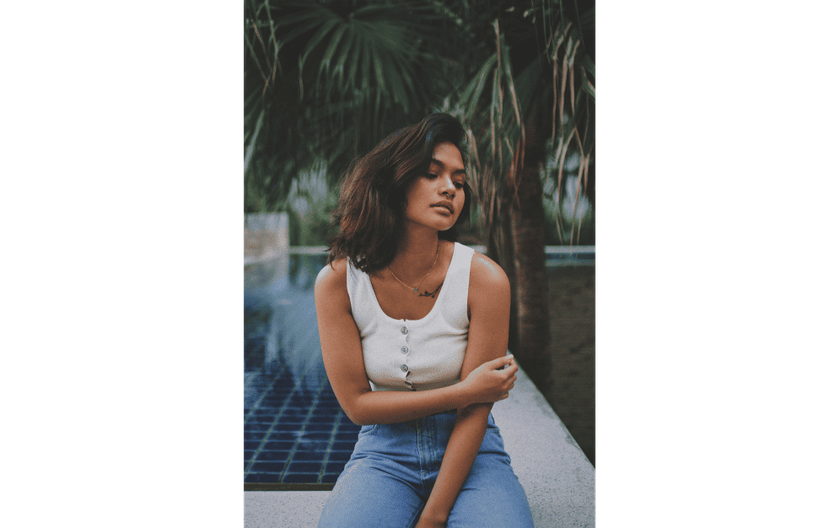
撮影した写真を見返したときに、モデルのポーズに違和感を感じることはありませんか?ポートレート撮影でよくあるミスを防ぐために、以下のポイントをチェックしてみましょう。
ミス①:硬直した「彫像ポーズ」
モデルはカメラの前でリラックスし、自然に振る舞っていますか?体の緊張、特に肩や手足の緊張に注意してください。感情表現が先行し、体が完璧でないように見えることがありますが、大丈夫です!最終的なイメージは、ボディフォトエディターでいつでも修正できます。しかし、硬く、生気のないポーズは修正するのが難しい。本物の生き生きとした感情を撮影する方が良いのです。本物の瞬間のエネルギーは、どんなエディターでも再現できないからです。
ミス②:「頑張りすぎ」な姿勢
カメラの前に立つと、自分の姿勢を意識しすぎて過度に矯正してしまうことがあります。その結果、不自然な立ち方になってしまうことも。背筋を伸ばし、肩を落とし、胸を開くことは大切ですが、それが無理のない自然な状態であるかを確認しましょう。
ミス③:「手はどうすればいいの?」問題
ヒーローショットを狙っているのに、モデルの手が前で組まれていたりしませんか?手の位置は、意図するテーマに合ったボディランゲージを表現する重要な要素です。すでに前述の通り、手の使い方によって写真の印象は大きく変わります。
ミス④:無理のある表情
モデルの顔はテーマに合わせる必要があるので、シリアスでムーディなセットに明るい笑顔はぶつかります。モデルの顔が不自然に見えたり、ポーズが多すぎたりする場合は、リラックスしてもらいましょう。あごを少し下に向け、目線はカメラに向け、舌は口角を上げ、唇を少し離すと、モデルにふさわしい表情になります。
ミス⑤:誇張しすぎたポーズ
ポーズがあまりにも極端で不自然だと、写真全体がわざとらしくなり、撮影の効果が半減してしまいます。無理なポーズを求めるのではなく、小さな動きを重ねながら徐々に表現を広げていくように指示しましょう。また、モデルが快適に感じているかを常にチェックしながら進めることで、より自然な仕上がりになります。
ミス⑥:ボディランゲージの重要性を無視する
手の動きについてはすでに触れましたが、実は体全体の姿勢が視聴者にメッセージを伝えています。立ち方や体の傾き、肩の位置など、すべてが写真の印象を左右します。ボディランゲージの基本を理解し、撮影の意図に合ったポーズを意識することが重要です。
ミス⑦:無言のカメラマン
撮影を成功させるためには、コミュニケーションが鍵となります。モデル自身は、自分がどのように写っているかをリアルタイムで確認できません。それを見ているのはカメラマンだけなので、最適な結果を得るためには、的確な指示を出すことが重要です。シンプルな指示を明確に伝え、撮影の合間にモデルを励ましたり、良いポーズを褒めたりすることで、モデルの自信と表現力が高まり、より魅力的な写真につながります。
モデルの中には、シャッター音に合わせて流れるようにポーズを変えていく人もいれば、次の指示を待つ人もいます。どちらの場合でも、カメラマンが主体となってモデルと協力し、最適なポーズを引き出すことが重要です。数枚撮影したら、モデルをカメラやPCの画面の前に招き、一緒に写真を確認してみましょう。これにより、モデル自身もどのポーズが良いのかを把握しやすくなり、より効果的な撮影につながります。
モデルとの撮影経験を積むにつれて、ポージングの問題を素早く見抜き、スムーズに修正できるようになります。また、モデルによっては撮影に慣れるまで時間がかかることもあるため、最初にテストショットをいくつか撮り、ライティングを調整しながらリラックスできる環境を整えるのも良い方法です。撮影の雰囲気を和らげることで、より自然で魅力的な写真を引き出すことができるでしょう。
まとめ
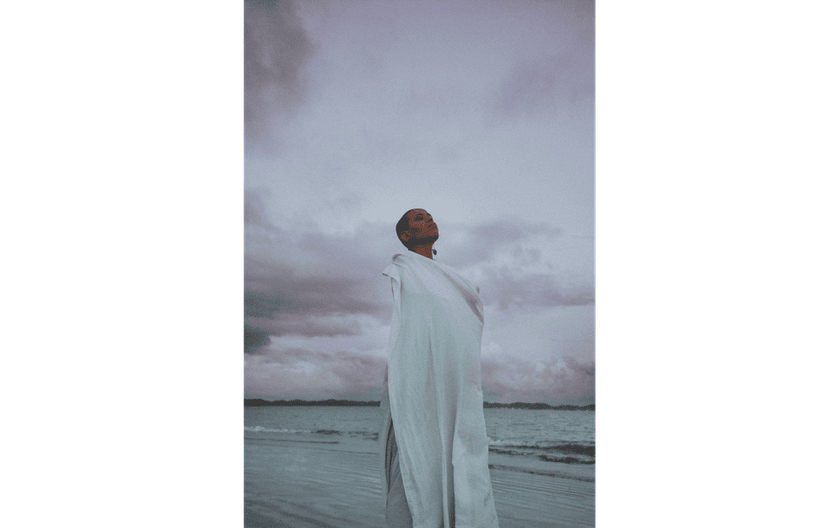
モデルとの協力は、ポートレート撮影の技術とは別に習得すべき貴重なスキルです。効果的なコミュニケーションとディレクションを身につけることで、視線を引きつける魅力的な写真を撮影できるようになります。撮影前には、詳細なプランを共有し、モデルがリラックスできる環境を整えましょう。モデルが何を求められているのかを理解していれば、撮影がスムーズに進み、より自然で洗練されたポーズを引き出せます。
撮影中は常にポジティブな声かけと指示を行い、モデルが自信を持てるようサポートすることが大切です。また、適宜画像を一緒に確認し、モデル自身がポーズや表情を調整できるようにするのも効果的な方法です。
最も大切なのは、撮影を楽しむこと。モデルとカメラマンがともに楽しい時間を過ごすことで、自然で魅力的な作品が生まれます。経験を積むほどスムーズに撮影できるようになり、やがて雑誌の表紙を飾るような一枚も撮れるようになるでしょう。
